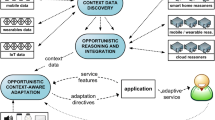Abstract
Pervasive healthcare systems facilitate various aspects of research including sensor technology, software technology, artificial intelligence and human-computer interaction. Researchers can often benefit from access to real-world data sets against which to evaluate new approaches and algorithms. Whilst more than a dozen data sets are currently publicly available, their use of heterogeneous mark-up impedes widespread and easy use. We describe \(\mathcal{PI}\)—the Perceiver and semantic Interpreter—which offers a workbench API for the querying, re-structuring and re-purposing of a range of diverse data formats currently in use. The use of a single API reduces cognitive overload, improves access, and supports integration of generic and domain-specific information within a common framework.






Similar content being viewed by others
References
Berners-Lee T (2005) Notation 3: a compact RDF syntax. http://www.w3.org/DesignIssues/Notation3. Accessed 23 April 2012
Chen H (2004) An intelligent broker architecture for pervasive context-aware systems. PhD thesis, University of Maryland
CHI-Workshop (2009) CHI-workshop on developing shared home behavior datasets to advance HCI and ubiquitous computing research. http://boxlab.wikispaces.com/List+of+Home+Datasets. Accessed 23 April 2012
Chu X, Buyya R (2007) Service oriented sensor web. In: Sensor Networks and Configuration, Springer, Berlin Heidelberg, pp 51–74
Cook D, Edgecombe MS, Crandall A, Sanders C, Thomas B (2009) Collecting and disseminating smart home sensor data in the CASAS project. In: Proceedings of the CHI 2009 workshops
Cook DJ, Das SK (2007) How smart are our environments? An updated look at the state of the art. Pervasive Mob Comput 3(2):53–73
Gu T, Pung HK, Zhang DQ (2005) A service-oriented middleware for building context-aware services. J Netw Comput Appl 28(1):1–18
Hagglund M, Scandurra I, Mostrom D, Koch S (2007) Bridging the gap: a virtual health record for integrated home care. Int J Integr Care 7(27)
Hossein S, Hedal S, Mendez-Vasquez A (2009) Sensory data set description language specification. Tech. Rep. SDDL_Specification_v1.0, University of Florida
JSON (2002) Javascript object notation (JSON). http://www.json.org/. Accessed 23 April 2012
van Kasteren T, Noulas A, Englebienne G, Kröse B (2008) Accurate activity recognition in a home setting. In: Proceedings of International Conference on Ubiquitous Computing (UbiComp ’08), ACM, pp 1–9
Logan B, Healey J, Philipose M, Tapia EM, Intille SS (2007) A long-term evaluation of sensing modalities for activity recognition. In: Proceeding of International Conference on Ubiquitous Computing (Ubicomp 2007), Innsbruck, Austria, pp 483–500
Pentney W, Philipose M, Bilmes J, Kautz H (2007) Learning large scale common sense models of everyday life. In: Proceedings of AAAI 2007, pp 465–470
Provenance (2006) PML2 provenance ontology. http://iw.stanford.edu/2006/06/pml-provenance.owl. Accessed 23 April 2012
Román M, Hess C, Cerqueira R, Ranganathan A, Campbell RH, Nahrstedt K (2002) Gaia: a middleware platform for active spaces. SIGMOBILE Mobile Comput Commun Rev 6:65–67
Russomanno D, Kothari C, Thomas O (2005a) Sensor ontologies: From shallow to deep models. In: Proceedings of the 37th Southeastern Symposium on System Theory (SSST ’05), pp 107–112
Russomanno DJ, Kothari CR, Thomas OA (2005b) Building a sensor ontology: a practical approach leveraging ISO and OGC models. In: Proceedings of the 2005 International Conference on Artificial Intelligence, Las Vegas, USA, pp 637–643
Stevenson G, Knox S, Dobson S, Nixon P (2009) Ontonym: a collection of upper ontologies for developing pervasive systems. In: Proceedings of the 1st Workshop on Context, Information and Ontologies, ACM, Heraklion, Greece, p 1–8
la Torre FD, Hodgins J, Montano J, Valcarcel S, Bargteil A, Martin X, Macey J, Collado A, Beltran P (2008) Guide to the carnegie mellon university multimodal activity (CMU-MMAC) database. Tech. Rep. CMU-RI-TR-08-22, Robotics Institute, Carnegie Mellon University
Witten IH, Frank E (2005) Data mining: practical machine learning tools and techniques. Morgan Kaufmann San Fransisco
Yang AY, Jafari R, Sastry SS, Bajcsy R (2009) Distributed recognition of human actions using wearable motion sensor networks. J Ambient Intell Smart Environ 1:103–115
Ye J, Coyle L, Dobson S, Nixon P (2007) Ontology-based models in pervasive computing systems. Knowl Eng Rev 22:315–347
Ye J, McKeever S, Coyle L, Neely S, Dobson S (2008) Resolving uncertainty in context integration and abstraction. In: Proceedings of International Conference on Pervasive Services (ICPS 2008), ACM, pp 131–140
Ye J, Stevenson G, Dobson S, O’Grady M, O’Hare G (2011) Pi: Perceiver and interpreter of smart home datasets. In: Proceedings of the 5th International ICST Conference on Pervasive Computing Technologies for Healthcare (PervasiveHealth 2011), Dublin, Ireland
Acknowledgments
We would like to thank the editors and anonymous reviewers for their valuable comments and suggestions to improve the readability and technical quality of our paper.
Author information
Authors and Affiliations
Corresponding author
Rights and permissions
About this article
Cite this article
Ye, J., Stevenson, G., Dobson, S. et al. Perceiving and interpreting smart home datasets with \(\mathcal{PI}\) . J Ambient Intell Human Comput 4, 717–729 (2013). https://doi.org/10.1007/s12652-012-0148-5
Received:
Accepted:
Published:
Issue Date:
DOI: https://doi.org/10.1007/s12652-012-0148-5




